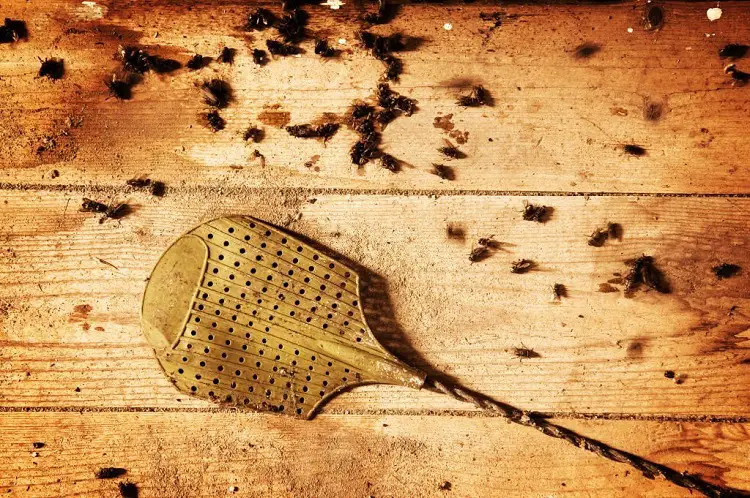Can you kill a wasp with a fly swatter? This is a normal question to ask when you are faced with a wasp buzzing around your space.
While it’s possible to use a fly swatter to kill a wasp, it might not be the best approach.
The effectiveness of fly swatter on wasps likely depends on the type of fly swatter used, the location where it is deployed, and the specific species of wasps present.
Wasps are fascinating insects with their slender bodies, narrow waists, and vibrant patterns.
With thousands of species found in different habitats around the world, they truly are the daredevils of the insect kingdom.
Although fly swatters are designed to handle smaller flying pests like flies, they can still be used to take out wasps.
So, next time you find yourself in a wasp situation, consider using a fly swatter, and show those wasps who’s boss!
Table of Contents
- Wasp
- Fly Swatter
- Can You Kill A Wasp With A Fly Swatter?
- Precautions on How To Use A Fly Swatter To Kill Wasp
- Alternatives to Fly Swatter When Dealing With Wasps
- Conclusion
Wasp
Wasps are insects characterized by their slender bodies, narrow waists, and often brightly colored patterns.
There are thousands of species of wasps, and they can be found in a wide range of habitats around the world.
Wasps play important ecological roles as pollinators and as predators of other insects. They are known for their ability to capture and paralyze insects to feed their young.
Many wasp species are also beneficial to humans as they help control pest populations in gardens and agricultural settings.
It’s important to note that while some wasps can deliver painful stings, not all wasps are aggressive towards humans. Some species are quite docile and won’t sting unless provoked.
However, for individuals who are allergic to wasp stings, a sting can trigger a severe allergic reaction known as anaphylaxis, which requires immediate medical attention.
If you encounter wasps, it’s generally best to remain calm and avoid sudden movements.
If you need to deal with a wasp nest or infestation near your home, it’s often best to contact a professional pest control service to handle the situation safely.
Types of Warps
Wasps are a diverse group of insects that can be classified into two main categories – social and solitary wasps.
Social wasps, as the name suggests, live in organized colonies and have a hierarchical structure with a queen as the leader.
Some examples of social wasps include yellow jackets, paper wasps, and hornets. Solitary wasps, on the other hand, live alone and do not form colonies.
They usually hunt and feed on small insects and spiders. Some examples of solitary wasps include cicada killers, mud daubers, and potter wasps.
Additionally, there are parasitic wasps that lay their eggs on other insects, which then serve as hosts for their larvae.
Fly Swatter
A fly swatter is designed to target smaller flying insects like flies, it might not be the most effective tool for dealing with wasps.
Wasps are generally larger, more aggressive, and have a more potent sting than flies. Using a fly swatter to kill a wasp could potentially agitate the wasp and put you at risk of getting stung.
If you have a wasp infestation or encounter a wasp in your living space, it’s generally safer and more effective to use professional pest control methods or products designed specifically for dealing with wasps.
If you must remove a single wasp, consider using a wasp-specific spray that can be used from a distance to minimize your risk of getting stung.
Always exercise caution when dealing with stinging insects to avoid any potential harm.
Can You Kill A Wasp With A Fly Swatter?

Fly swatter sure can be used to kill wasps because a fly swatter is designed to target smaller flying insects like flies.
Ultimately, the effectiveness of fly swatter on wasps likely depends on a variety of factors, including the type of fly swatter used, the location where it is deployed, and the specific species of wasps that are present.
Precautions on How To Use A Fly Swatter To Kill Wasp
Wasps are generally larger and more aggressive than flies, and they have a stinger that can cause pain or allergic reactions in some individuals.
If you decide to use a fly swatter to kill a wasp, keep the following tips in mind:
1. Identify the Wasp
It is important to take precautions before attempting to eliminate a flying insect that is causing a nuisance.
To avoid harming harmless insects like flies, it is essential to identify the intruder first.
Typically, wasps have slender bodies with a narrow waist that sets them apart from other insects.
Additionally, wasps are usually more brightly colored than flies, making them easier to spot.
Therefore, it is crucial to observe the physical characteristics of the insect before taking any action, as this will help ensure that the correct course of action is taken.
2. Choose the Right Tool
If you’re dealing with a wasp infestation, swatting them with a fly swatter might not be the best approach.
In fact, it could be dangerous as wasps can sting multiple times and may become aggressive when provoked. Instead, it’s recommended to use an insecticide that is specially formulated for wasps.
These insecticides can be highly effective in immobilizing or killing wasps from a safe distance.
You can find various types of sprays designed specifically for wasps on Amazon, which can be applied to nests or directly onto individual wasps.
It’s important to read the instructions carefully before using any insecticide and take all necessary safety precautions to avoid any potential harm to yourself or others.
3. Wait for Dusk
If you’re dealing with a wasp infestation, it’s important to choose the right time to take action. Wasps tend to be less active during the evening, making it a safer time to deal with them.
As the sun begins to set and the temperature cools down, the wasps become more sluggish and less likely to defend their nest aggressively.
This makes it easier to approach the nest and spray it with insecticide or remove it if necessary.
However, it’s important to be fully protected with appropriate clothing and gear while dealing with wasps at any time.
4. Be Cautious
Wasps can be more aggressive than flies, and they might sting in defense if they feel threatened. Approach the wasp cautiously and be prepared to move quickly if it becomes agitated.
5. Avoid Agitating Them
If you come across a wasp, try to remain calm and refrain from making any abrupt movements.
Wasps can sense even the slightest of movements and may interpret them as a threat, which could trigger an attack.
Moreover, when a wasp feels threatened, it releases pheromones that signal other wasps to join in the attack, making the situation even more dangerous.
Therefore, it’s best to stay still and avoid waving your arms around, as it could provoke the wasp to sting you.
6. Stay Still
If a wasp comes close to you, it’s important to remain calm and still. Avoid flailing your arms or swatting at the wasp.
This can make the insect feel threatened and more likely to sting you. Instead, try to slowly and calmly move away from the wasp until you are out of its range.
Remember that wasps are important pollinators and are generally only aggressive when they feel threatened.
By remaining calm and still, you can avoid agitating them and prevent any potential harm to yourself.
7. Move Slowly
If you need to move away from a wasp, do so slowly and steadily. Gradually move to a safe distance to reduce the chance of provoking the wasp.
8. Aim for Accuracy
Unlike flies, wasps can move quickly and erratically, which can make swatting them a difficult task.
To increase your chances of success, it’s best to time your swat when the wasp is stationary or moving at a slower pace.
This will give you a better chance of making contact and successfully getting rid of the pest.
9. Watch Your Surroundings
Make sure you’re in a safe environment where you won’t accidentally hit other objects or people while trying to swat the wasp.
10. Quick and Decisive Action
If you decide to go ahead with this method, swat the wasp with a quick and forceful motion to increase your chances of hitting it accurately.
11. Timing
Wait for the right moment to strike. Try to predict the wasp’s movements and anticipate when it will be within your reach.
12. Protect Yourself
Additionally, it is suggested to wear gloves and a hat to protect your hands and head respectively. Avoid wearing perfumes or scented lotions as they may attract wasps.
When outside, be aware of your surroundings and try to avoid areas where wasps are present.
13. Disposal
Once the wasp is dealt with, carefully pick it up using gloves or a tissue, and dispose of it in a sealed container or a trash bag. This can help prevent other insects from being attracted to the scent of the dead wasp.
Read Also: Does Killing a Wasp Attract More? Explained
Alternatives to Fly Swatter When Dealing With Wasps

Chemical Sprays
Chemical sprays are a type of insecticide that can be used to effectively kill wasps.
These sprays typically contain active ingredients such as pyrethroids or organophosphates, which work by interfering with the nervous system of the wasp, ultimately leading to its death.
It is important to carefully read and follow the instructions on the label when using these sprays, as they can be harmful to humans and pets if not used properly.
Additionally, it is recommended to wear protective clothing and to aim for the nest from a safe distance to minimize the risk of being stung by the wasps.
Traps
Wasps can be a nuisance, especially during the warmer months.
There are several ways to get rid of them, and one of the most effective methods is by using traps.
Traps for killing Wasps come in different types, including homemade and store-bought options.
Homemade traps can be made using simple household items such as soda bottles or jars, filled with a sweet solution to attract the Wasps.
Store-bought traps are usually made of plastic and come with attractants that lure the Wasps in. Once the Wasps are inside the trap, they are unable to escape and eventually die.
It’s important to dispose of the traps properly to avoid attracting more Wasps or other insects.
Natural Remedies
While there are many chemical sprays and insecticides available to kill wasps, some people prefer to use natural remedies.
Some effective natural remedies for killing wasps include spraying them with a mixture of soap and water, using a trap made from a plastic bottle and a sweet liquid, or using essential oils such as peppermint or clove oil to repel them.
It’s important to exercise caution when dealing with wasps and to take appropriate safety measures to avoid getting stung.
Read Also: Do LED Lights Attract Spiders?
Conclusion
I hope this article has given in-depth knowledge to answer the question “Can you kill a wasp with a fly swatter?.
Fly swatter sure can be used to kill wasps because a fly swatter is designed to target smaller flying insects like flies. It might not be the most effective tool for dealing with wasps but it can surely kill wasps.


